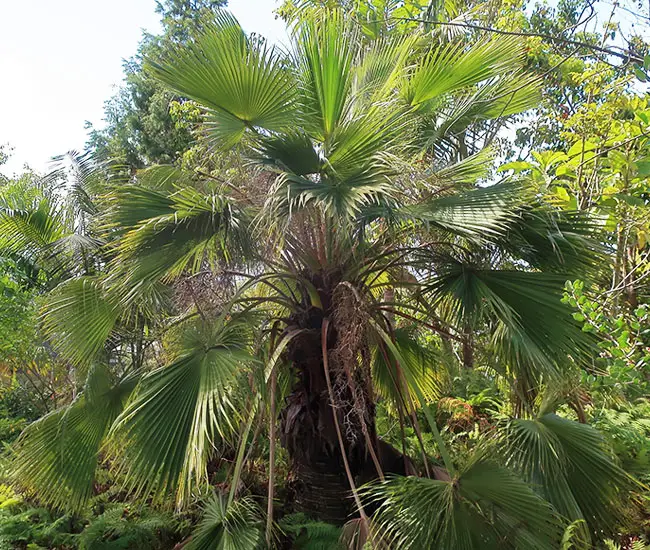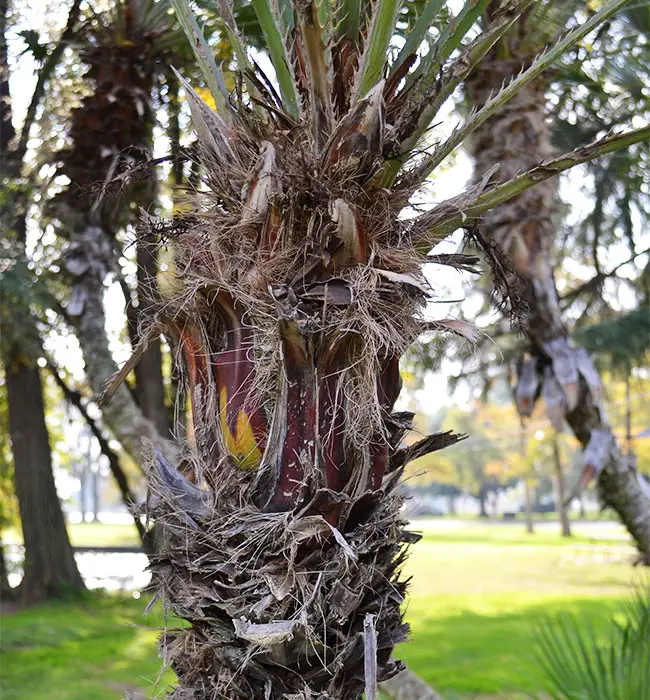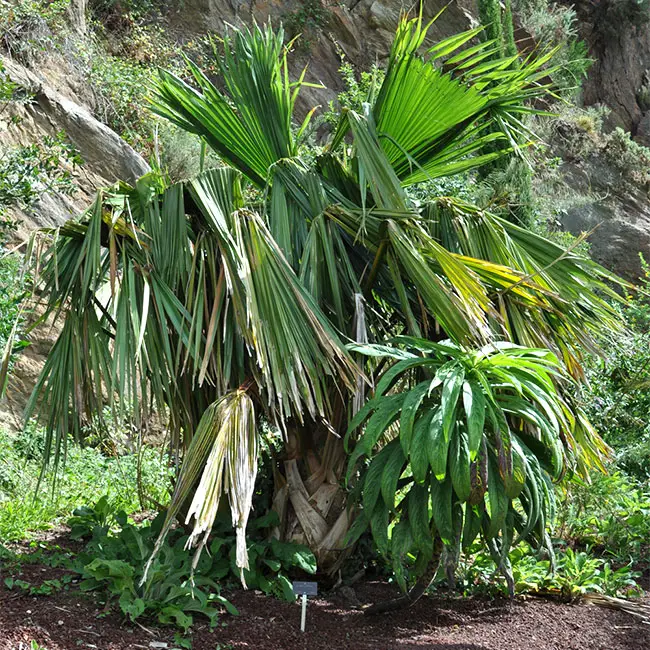
The Guadalupe Palm, scientifically known as Brahea edulis, is a striking palm species native to Guadalupe Island, part of Mexico. It is a slow-growing, solitary palm with a stout trunk that can reach heights of up to 40 feet (12 meters). The trunk is often grayish-brown and features the distinctive diamond-shaped leaf scars left by old fronds.
In cultivation, the Guadalupe Palm is favored for its striking appearance and adaptability to various climates. It is often used in landscaping and can withstand both full sun and partial shade. However, it’s essential to provide well-draining soil for this palm to thrive.
This palm is cold hardy down to 20°F, so it can be grown in states like Georgia, Louisiana, Nevada, Oregon, South Carolina, Texas, and Washington.
Quick Facts:
| Scientific name: | Brahea edulis |
| Common names: | Guadalupe Palm |
| Origin: | Native to Guadalupe Island off west coast of Mexico |
| Growth Rate: | Slow. Up to 30 ft tall and 10 ft wide. |
| Cold Tolerance: | USDA Zones 10a (30 – 35 F) to 11 (above 40 F). |
| Light Req: | Full sun. |
| Water Req: | Low |
| Soil Req: | Widely adaptable |
| Fruit: | Yes. Black. Sweet and edible. |
| Propagation: | By seed, germinating in 2 – 4 months. |
Guadalupe Palm Appearance
The Guadalupe Palm’s unique combination of stout trunk, blue-green fronds, and drought-resistant nature make it an attractive addition to gardens and landscapes, particularly in regions with arid or Mediterranean climates.
The palm’s trunk is stout and can reach heights of up to 40 feet (12 meters). It typically has a grayish-brown color and is adorned with diamond-shaped leaf scars, remnants of old fronds.
Guadalupe Palm fronds are fan-shaped and can grow quite large, measuring between 5 to 8 feet (1.5 to 2.4 meters) in length. These fronds have a striking blue-green color, contributing to the palm’s overall visual appeal.
Flowers and Fruits of the Guadalupe Palm
The Guadalupe Palm produces small, inconspicuous flowers and round fruit. The flowers are typically cream-colored and are arranged in clusters, but they are not particularly showy.
As for the fruit, the Guadalupe Palm produces small, round berries that are initially green but turn dark brown or black when ripe. These fruits are typically about 0.5 to 0.75 inches (1.3 to 2 centimeters) in diameter and are not commonly consumed by humans.
However, they serve as a valuable food source for various wildlife species in the palm’s native habitat.
Caring for the Guadalupe Palm
Guadalupe Palms prefer full to partial sun, so ensure they receive adequate sunlight in your chosen location. Plant them in well-draining soil to prevent waterlogging, which can be harmful to the palms.
While they are drought-tolerant once established, provide regular watering during their initial growth phase to help establish a strong root system. Afterward, water during dry periods to maintain soil moisture.
Guadalupe Palms don’t have high fertilizer needs. Applying a balanced, slow-release palm fertilizer once or twice a year during the growing season should suffice. Avoid excessive fertilization.
Pruning is typically minimal and may involve removing dead or damaged fronds. Be careful not to over-prune, as this can stress the palm.
The Guadalupe Palm is renowned for its impressive cold hardiness. It can withstand cold temperatures down to approximately 15°F to 20°F (-9°C to -7°C) and is typically suitable for USDA hardiness zones 8b to 11.
This exceptional cold tolerance makes it well-suited for regions with relatively mild winters, where it can endure occasional frost and chilly conditions without significant damage.
However, providing some protection, especially for younger or less established palms, during severe cold snaps can help ensure their survival and overall health.
Guadalupe Palms are relatively pest-resistant, but periodic inspection for common pests such as scale and mites is recommended. Use appropriate treatments if pests are detected.
Guadalupe Palm Propagation
Propagated by seeds. It is recommended to sown as soon as it is ripe in a warm greenhouse at not less than 24°c. It usually takes 3 – 6 months at 25°c for germination. If you store seeds it will be very slow to germinate. Make sure to soak the seed for 24 hours in warm water prior to sowing. This may shorten the germination time.
Plants form a long tap-root some time before forming a shoot so it is best to sow 2 – 3 seeds per deep pot. Grow the seedlings on in the greenhouse for at least their first three winters.
It is best to plant them out into their permanent positions in late spring or early summer, after the last expected frosts.
Guadalupe Palm Pictures


